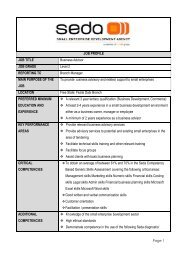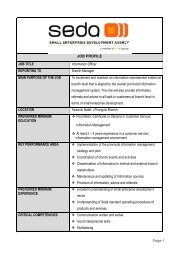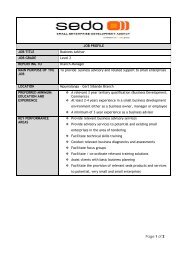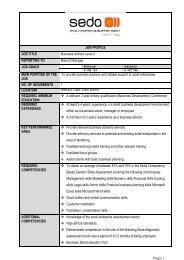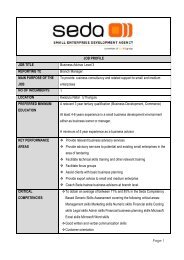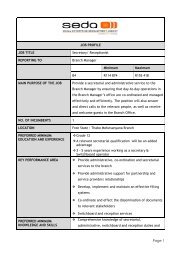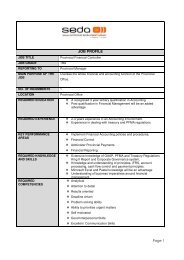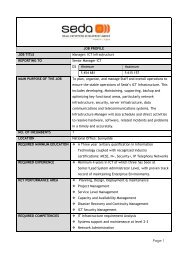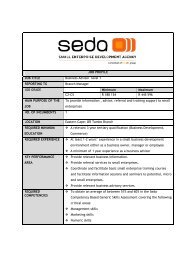Assessment of Cooperatives in the Poultry Industry - 2013.pdf - Seda
Assessment of Cooperatives in the Poultry Industry - 2013.pdf - Seda
Assessment of Cooperatives in the Poultry Industry - 2013.pdf - Seda
Create successful ePaper yourself
Turn your PDF publications into a flip-book with our unique Google optimized e-Paper software.
2013<br />
Research Report: Address<strong>in</strong>g <strong>the</strong> Needs, Opportunities and Challenges <strong>of</strong> <strong>Cooperatives</strong><br />
and Collectively Owned Enterprises <strong>in</strong> <strong>the</strong> <strong>Poultry</strong> and Related Industries<br />
employed casually <strong>in</strong> <strong>the</strong> formal agricultural sector <strong>in</strong> 2007.<br />
This equates to 796 806 people employed <strong>in</strong> <strong>the</strong> formal agriculture <strong>in</strong>dustry <strong>in</strong> 2007. There is a three<br />
year time difference between <strong>the</strong>se two sets <strong>of</strong> statistics, however, consider<strong>in</strong>g that <strong>the</strong> poultry<br />
<strong>in</strong>dustry is only one part <strong>of</strong> this, a total <strong>of</strong> around 445 000 people employed directly and <strong>in</strong>directly<br />
through <strong>the</strong> <strong>in</strong>dustry is a relatively high figure (SAPA, 2011) (Stats SA, 2007). Even if only direct<br />
employment is considered, <strong>the</strong> poultry <strong>in</strong>dustry would still account for approximately 10% <strong>of</strong><br />
agricultural employment.<br />
Implications for <strong>the</strong> <strong>Cooperatives</strong> <strong>in</strong> <strong>the</strong> <strong>Poultry</strong> <strong>Industry</strong>:<br />
Only 15.7% <strong>of</strong> employment <strong>in</strong> <strong>the</strong> poultry <strong>in</strong>dustry is through direct employment; <strong>the</strong> rema<strong>in</strong><strong>in</strong>g 84.3% is<br />
through <strong>in</strong>formal/<strong>in</strong>direct employment. The large percentage <strong>of</strong> <strong>in</strong>formal/<strong>in</strong>direct employment illustrates<br />
a large amount <strong>of</strong> scope for support by cooperatives <strong>in</strong> meet<strong>in</strong>g <strong>the</strong> demands <strong>of</strong> <strong>the</strong> <strong>in</strong>dustry.<br />
2.2.3.<br />
Import/Export<br />
The figures <strong>in</strong>dicat<strong>in</strong>g imports and exports illustrate how well <strong>the</strong> South African poultry <strong>in</strong>dustry is<br />
perform<strong>in</strong>g <strong>in</strong> relation to <strong>the</strong> <strong>in</strong>ternational poultry market. A low number <strong>of</strong> imports and high<br />
number <strong>of</strong> exports is <strong>the</strong> ideal situation as this shows that South Africa is produc<strong>in</strong>g more than it is<br />
consum<strong>in</strong>g and also that South African poultry is competitive on <strong>the</strong> <strong>in</strong>ternational market.<br />
Table 2-1: Imports and Exports <strong>in</strong> Egg and Broiler Production<br />
Imports<br />
Exports<br />
(as a percentage <strong>of</strong> domestic consumption)<br />
Broiler 8.96% 0.97%<br />
Egg 22% 1.3%<br />
Source: South African <strong>Poultry</strong> Association, 2012<br />
However, <strong>the</strong> domestic poultry <strong>in</strong>dustry stands at a negative balance <strong>of</strong> payment on <strong>the</strong><br />
import/export front as seen <strong>in</strong> <strong>the</strong> table above. This <strong>in</strong>dicates that we<br />
are import<strong>in</strong>g more than we are export<strong>in</strong>g. Approximately 9% <strong>of</strong><br />
broiler meat consumption is from imported meat and approximately<br />
22% <strong>of</strong> egg consumption is imported. Only 1.3% <strong>of</strong> egg production is<br />
exported, <strong>in</strong>dicat<strong>in</strong>g that <strong>the</strong> Republic <strong>of</strong> South Africa (RSA) is<br />
import<strong>in</strong>g a far greater quantity <strong>of</strong> eggs than is be<strong>in</strong>g exported.<br />
South Africa<br />
imports far<br />
more eggs<br />
and broilers<br />
than it<br />
exports<br />
Amongst o<strong>the</strong>r factors, <strong>the</strong> lower costs <strong>of</strong> <strong>in</strong>puts such as feed <strong>in</strong><br />
compet<strong>in</strong>g nations (for example Brazil) create a lower production cost<br />
which is difficult for South African producers to compete with. The table below illustrates <strong>the</strong><br />
differences <strong>in</strong> gra<strong>in</strong> prices between South Africa, <strong>the</strong> United States <strong>of</strong> America (USA) and Brazil. This<br />
9 | P a g e U r b a n - E c o n : D e v e l o p m e n t E c o n o m i s t s



